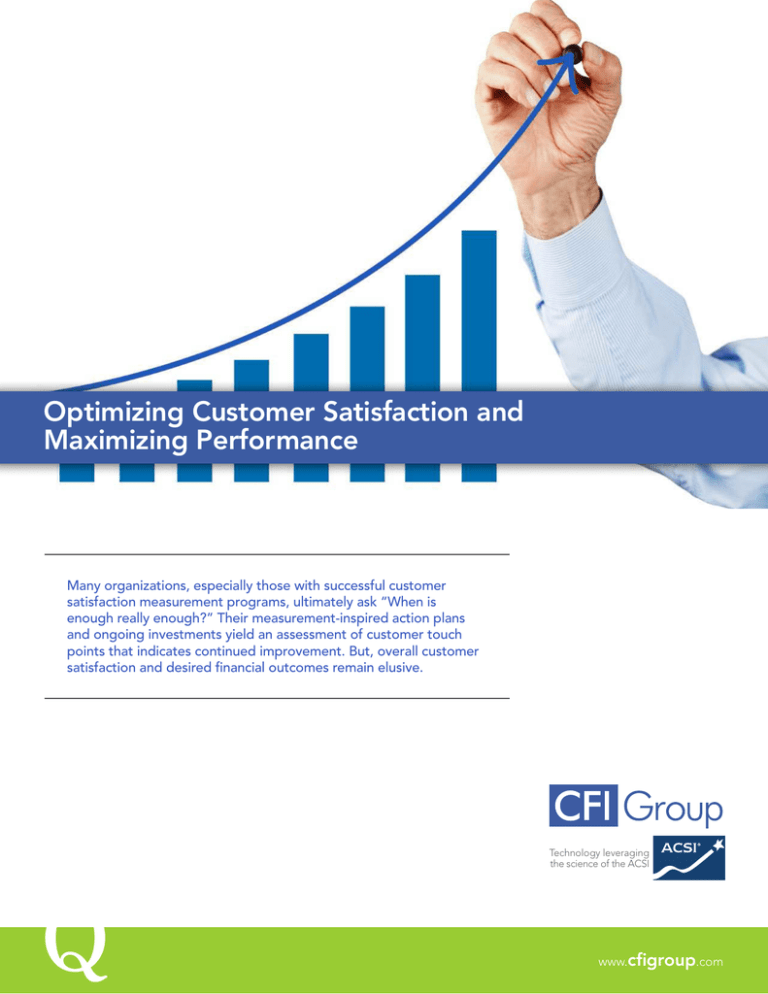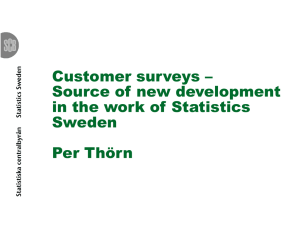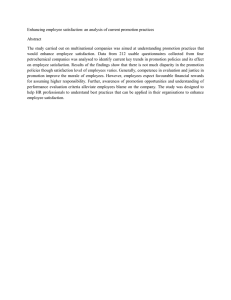
Optimizing Customer Satisfaction and
Maximizing Performance
Many organizations, especially those with successful customer
satisfaction measurement programs, ultimately ask “When is
enough really enough?” Their measurement-inspired action plans
and ongoing investments yield an assessment of customer touch
points that indicates continued improvement. But, overall customer
satisfaction and desired financial outcomes remain elusive.
Technology leveraging
the science of the ACSI
© 2012 CFI Group.
All rights reserved.
1
www.cfigroup.com
Introduction
Financial returns from an effective measurement
program are the result of optimizing investments
in customer satisfaction, that is, avoiding both
under investment and over investment in
performance improvement. The operational
questions thus become “How do you avoid under
investing when performance improvements are
expensive and there appears to be no potential
for a return in customer satisfaction?” and “At
what point should a company stop investing in
performance improvements because there is
no real additional return available (customers
cannot buy more and they can not be more
loyal)?”
The reality is that customers do not respond in
a linear fashion to the improved performance
of a product or service provider. Very rarely do
we see, across a wide spectrum, consistent
company performance improvement met by
consistently more favorable customer behavior.
In fact, most customer behavior is impacted by
non-linear diminishing returns. In this context,
exceeding customer expectations may sound
like a good goal but does not make good
business sense. The provider gains little or no
return on customer satisfaction investments
and misses the opportunity for better returns
elsewhere.
The Complexities of Customer Behavior
Non-linear returns on customer satisfaction
investments manifest the deep complexities
of customer behavior. This is especially the
case when customer satisfaction approaches
an expected or ideal level. The optimization of
investments in customer satisfaction requires
an analysis that goes to the root of these
expectations and their resulting behaviors
(or lack thereof). Examples of sector-related
performance improvements resulting in nonlinear customer behavior include:
© 2012 CFI Group.
All rights reserved.
•
Financial Services – loan processing
time, fee/cost sensitivity, branch density
•
Retail – availability of associates,
time to check out, problem resolution
outcomes
•
Contact Centers – time to answer, time
to resolution, first-call resolution
•
General Services – performance,
reliability, warranty and returns
In these examples, we observe that a
company’s performance improvement has
varying impacts on customer behavior. And,
depending on a number of factors, better
company performance does not always produce
the sought-after customer behavior. Specifically,
many companies focus their improvement
efforts on areas they believe will yield a linear
change in customer behavior. These companies
base their customer satisfaction action plans
(measurement programs) on the premise
that, for every increment of improvement in
performance, their customers predictably will
change behavior.
2
avoids expending resources in pursuit of a
point beyond which there will be no impact on
customer behavior.
H o w e v e r, t h e o r y h o l d s a n d p r a c t i c e
demonstrates that there are points at which
performance improvements do not produce
in-kind behavioral changes among customers.
These points are thresholds or levels at which
there is a shift in the relationship between input
(performance improvement) and output (change
in customer behavior). A lower threshold may
represent the point where performance has
no impact on customer satisfaction and/or the
point where performance must improve before
customer satisfaction will improve.
We can visualize the complexities of non-linear
customer behavior in a series of graphs that
track behavioral impacts, that is, the nonlinear relationships between performance
improvement and customer behavior (see
Figure 1). The most common shapes emergent
in these graphs are:*
A good example is the customer in the
checkout line who is very dissatisfied with a
ten-minute wait but not any more satisfied
with a five-minute wait. Here, the threshold
that positively impacts satisfaction (or at least
does not lessen it) occurs at some point under
five minutes. Conversely, an upper threshold
often represents performance that is beyond
the ability to drive customer satisfaction. Our
customer in the checkout line may be satisfied
with a one-minute wait, but not more satisfied
by a 20-second wait or even no wait at all.
•
A single change in slope, where
customer satisfaction does not change
until a minimum threshold is reached,
or where customer satisfaction stops
increasing as the upper threshold is
reached.
•
Two slope changes, also known as the
S- or Z-shaped ramp function, where
there is a combination of the minimum
and upper thresholds.
In this example, the company needs to establish
processes for staffing that will provide customer
service at intervals of less than five minutes,
but not less than one minute. Understanding
the non-linear relationship between improved
performance and customer satisfaction allows
management to tune staffing resources
effectively to optimize customer satisfaction.
With this understanding, management also
A less common non-linear shape for these relationships is the U- or V-shape. For example, this shape might represent a diner at
a restaurant who is not satisfied if the waiter does not appear within 15 minutes (poor service), and if the waiter shows up every 30
seconds (annoying excessive service). The diner’s satisfaction is achieved somewhere in between.
*
© 2012 CFI Group.
All rights reserved.
3
Behavioral Impacts
Linear
Figure 1
Thresholds
S - curve
(Ramp)
on investment) changes. For performance
improvement, this is critical to determining the
optimal mix of resource allocation to maximize
return.
From the perspective of statistical modeling,
we can construct a model that approximates
the customer behavior curve by identifying
the inflection points where the slope (return
Avoiding Over Investment
© 2012 CFI Group.
All rights reserved.
Determining the most effective allocation of
resources for performance improvement is
fundamental to any customer satisfaction
measurement program. A recent analysis
performed by CFI Group provides an excellent
example of the importance of empiricallybased investment decisions in avoiding over
investment in performance improvement.
facilities that would move customers more
quickly out of call queues.
The contact center of a major telecommunications company set a performance
improvement target for call abandonment
based on “best practice” benchmarks for
the industry. The company understood the
importance of call abandonment as a driver
of customer satisfaction. In order to reach the
call abandonment target, the company was
contemplating a major investment in expanded
evaluate company performance in this area,
and to validate the suggested target or offer a
different, empirically-based target. CFI Group
analyzed the company’s customer satisfaction
data and identified steeply diminishing returns
as call abandonment reached 7.1%. Customer
satisfaction showed no further improvement
when the abandonment rate reached 6.6%.
This was well short of the originally proposed
target of 5%.
The company’s call abandonment rate ran
consistently at 9.77%. Using their existing
benchmarks, management proposed an
improvement target of 5%, believing that this
would maximize customer satisfaction (see
Figure 2). The company asked CFI Group to
4
Optimizing Contact Center Metrics
Qualitative “best practice” indicated 5% was a good target.
9.77%
Figure 2
CFI Group’s analysis enabled the company
to make an empirically-based investment
decision and save approximately ten million
dollars in capital investment that would have
been needed to improve call abandonment
from 7.1% to 5%. Moreover, by using these
same investment dollars in other business
programs, the company was able to implement
a process improvement program involving an
automated phone tree and call queuing, both
of which optimized performance improvement
and maximized customer satisfaction.
Avoiding Under Investment
know if there was a point at which no further
improvement in return was possible.
It is also very common for companies to
under invest in some drivers of customer
satisfaction, especially when it is not clear
that a significant return on investment is still
possible. A recent project undertaken by CFI
Group with a business services firm offers a
strong example of the risks inherent in under
investing. After several years of hard work in
improving performance, achieving increased
customer satisfaction, and realizing positive
business outcomes, this company wanted to
© 2012 CFI Group.
All rights reserved.
The company had long since exceeded its
original customer satisfaction target of 80. CFI
Group analyzed existing customer satisfaction
data and identified the amount of additional
customer satisfaction still available through
improved customer service (see Figure 3).
5
Optimize Target Setting
Setting targets too low results in lost opportunity.
Figure 3
CFI Group also identified the point at which
satisfaction would be optimal and would
generate a maximum return from customers.
CFI Group’s analysis indicated that a revised
target of 84.2 would maximize the company’s
financial return. The company was able to make
an empirically-based decision to set a stretch
metric of 84.2, the point at which customers
would stop rewarding improvements in company
performance. By funding investments to achieve
these metrics, the firm was able to seize what
would otherwise have been a lost opportunity.
Successful Action Planning
An effective measurement program with a
customer-focused strategy is a closed-loop
process of action planning, performance
improvement, and ongoing measurement and
adjustment. Like a chain, the strategy is only
as strong as its weakest link. Optimized targets
© 2012 CFI Group.
All rights reserved.
and process metrics require statistical rigor and
a high level of precision. Without this rigor and
precision, management can not and should
not have confidence in a program’s suggested
course of action, or in the commitment to
make desired changes and investments
(see Figure 4).
6
Optimized Action Plans with Optimized Metrics
Figure 4
•
Action planning itself is successful only to the
extent that it aligns organizational resources –
people, processes and capital – in support of
customer strategy. The keys to success include:
•
•
© 2012 CFI Group.
All rights reserved.
Communications Programs. These
are necessary to support the
strategy’s overall goals and to ensure
empowerment and accountability for
the plan.
A Focus on Optimizing Customer
Satisfaction Investments. Optimizing
and prioritizing initiatives will maximize
financial outcomes and, ultimately,
market value.
Understanding the optimum link between a
driver of satisfaction and desired financial
outcomes (customer retention, up-selling/
cross-selling, price tolerance, and willingness
to recommend) is essential for any meaningful
customer-focused strategy.
Ongoing Measurement. This
determines whether or not the program
is yielding an expected return on
customer satisfaction. Timely and
accurate measurement results are
necessary to ensure the availability
of requisite resources, to identify
problems, and to take corrective action
promptly.
7
Conclusion
Even – perhaps especially – the most successful
customer satisfaction programs may not be
delivering optimum returns on investment.
Understanding areas of over and under
investment in performance improvement
requires insight into the mind of the customer
and the complexities of customer behavior.
This, in turn, can result in improved customer
satisfaction, a greater return on investment,
and a strengthening of overall competitiveness.
existing measurement data. Rather, it involves
the sophisticated use of psychometric and
measurement principles. Applying advanced
statistical techniques and expertise to an
existing measurement program often will bring
to light insights that are hidden by traditional
measurement approaches. If the goal is to use
customer satisfaction information to improve
business outcomes, it is important to recognize
that optimizing customer satisfaction, not
maximizing customer satisfaction, leads to
maximizing financial results.
Gaining these insights does not necessarily
require throwing out all of a company’s
For more information
please contact:
marketing@cfigroup.com
About CFI Group
About the ACSI
CFI Group is a global leader in providing customer
The American Customer Satisfaction Index (ACSI)
feedback insights through analytics. CFI Group
is the only uniform, cross-industry measure of
provides a technology platform that leverages the
customer satisfaction proven to predict financial
science of the American Customer Satisfaction
results. Founded at the University of Michigan’s Ross
Index (ACSI). This platform continuously measures
School of Business, the ACSI is a leading economic
the customer experience across multiple channels,
indicator of consumer spending in the United States.
b e n c h ma rk s p e rfo rm a n ce, and pri ori ti zes
The ACSI measures more than 230 companies and
improvements for maximum impact.
© 2012 CFI Group.
All rights reserved.
organizations across 43 industries, representing
Founded in 1988 and headquartered in Ann Arbor,
close to half of the U.S. economy. Nearly 20 years of
Michigan, CFI Group serves global clients from a
data from the ACSI show that customer satisfaction
network of offices worldwide. Our clients span a
is an indicator of financial results on both macro
variety of industries, including financial services,
and microeconomic levels, including shareholder
hospitality, manufacturing, telecom, retail and
value and cash flow volatility. The U.S. Federal
government. Regardless of your industry, we can
Government also uses the ACSI as the gold standard
put the power of our technology and the science of
of satisfaction measurement for its agencies.
the ACSI methodology to work for you.
8




